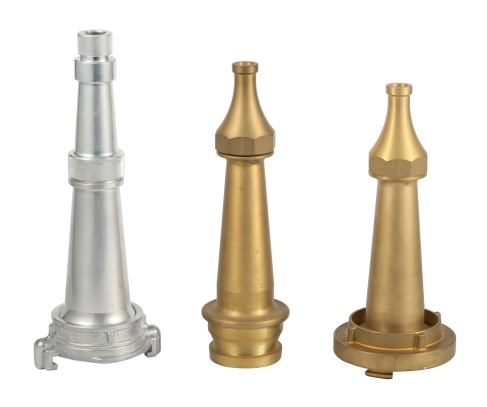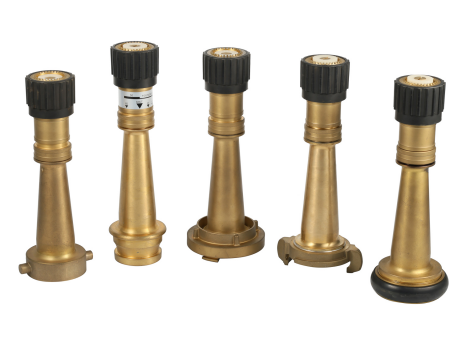
Selecting the appropriate nozzle material is crucial to ensure the effectiveness and reliability of fire safety equipment. I’ve seen how the material of fire nozzles impacts their performance, durability, and suitability for specific environments. Brass and stainless steel are two popular choices, each with unique advantages. But which one is better suited for fire nozzles? Let’s explore this question to help you make an informed decision.
Key Takeaways
- Brass nozzles perform well in heat transfer and are ideal for controlled environments.
- Stainless steel nozzles excel in durability and rust resistance for harsh conditions.
- Consider long-term costs when choosing between brass and stainless steel.
- Regular cleaning and inspection optimize performance for both types.
- Choose brass for cost-sensitive applications and stainless steel for demanding environments.
Brass Fire Nozzles
Performance and Characteristics
Brass is renowned for its excellent thermal conductivity and decent corrosion resistance. This copper-zinc alloy offers good machinability and durability. With a melting point of 927°C (1700°F) and density of 8.49 g/cm³, brass provides structural integrity. Its tensile strength ranges between 338–469 MPa, ensuring reliable performance under pressure. The material’s high electrical conductivity also enhances heat distribution efficiency.
Common Applications and Industries
Brass nozzles are widely used in firefighting, plumbing, and marine applications where corrosion resistance and heat transfer matter. They’re particularly effective in environments with moderate chemical exposure. The material’s malleability makes it ideal for custom nozzle designs requiring complex shapes.
Stainless Steel Fire Nozzles
Performance and Characteristics
Stainless steel boasts superior tensile strength (621 MPa) and elastic modulus (193 GPa). Its chromium content (≥10.5%) creates a self-repairing oxide layer, providing exceptional corrosion resistance. With a melting point of 1510°C (2750°F) and elongation at break of 70%, it maintains structural stability under extreme conditions.
Common Applications and Industries
Stainless steel nozzles dominate chemical processing, offshore platforms, and industrial fire systems. They’re preferred for applications requiring longevity and minimal maintenance in corrosive environments.
| Property | Brass | Stainless Steel |
|---|---|---|
| Density | 8.49 g/cm³ | 7.9–8.0 g/cm³ |
| Tensile Strength | 338–469 MPa | 621 MPa |
| Elongation at Break | 53% | 70% |
| Elastic Modulus | 97 GPa | 193 GPa |
| Melting Point | 927°C (1700°F) | 1510°C (2750°F) |
| Corrosion Resistance | Moderate | High |
| Thermal Conductivity | 109 W/m·K | 15 W/m·K |
Key Comparison Factors for Nozzle Materials
Durability
Abrasion Resistance
Stainless steel outperforms brass in abrasive environments due to higher hardness (150–200 HB vs 55–95 HB). For brass nozzles, implement filtration systems to reduce particle ingress and conduct quarterly wear inspections.
High-Pressure Performance
Stainless steel maintains integrity at pressures exceeding 300 psi, while brass may deform above 250 psi. Consider pressure ratings when selecting nozzle materials for hydraulic systems.
Corrosion Resistance
Brass Limitations
Brass nozzles develop patina over time when exposed to chlorides or sulfides. In marine environments, dezincification can occur within 2–3 years without proper coatings.
Stainless Steel Advantage
Type 316 stainless steel withstands salt spray for 1,000+ hours without red rust. Passivation treatments can boost corrosion resistance by 30% in acidic environments.
Thermal Conductivity
Brass Efficiency
Brass transfers heat 7x faster than stainless steel, making it ideal for applications requiring rapid temperature equalization. This property prevents localized overheating in continuous firefighting operations.
Stainless Steel Limitations
The low thermal conductivity of stainless steel requires careful thermal management. Nozzles may need cooling jackets in high-heat applications exceeding 400°C.
Tip: Brass nozzles are preferable for foam systems where thermal regulation impacts expansion ratios.
Weight Considerations
Operational Impact
Brass nozzles weigh 15–20% more than stainless steel equivalents. For handheld operations, this difference affects user fatigue:
- 1-1/4″ brass nozzle: 4.2 kg (9.25 lbs)
- Stainless steel equivalent: 3.5 kg (7.7 lbs)
Cost Analysis
Initial Costs
Brass nozzles cost 20–30% less initially. Typical price ranges:
- Brass: $150–$300
- Stainless steel: $250–$600
Lifecycle Costs
Stainless steel offers better ROI over 10+ years:
| Material | Replacement Cycle | 10-Year Cost |
|---|---|---|
| Brass | Every 5–7 years | $450–$900 |
| Stainless Steel | 15+ years | $250–$600 |
Material Selection Recommendations
When to Choose Brass
Ideal Use Cases
- Indoor fire suppression systems
- Low-chemical exposure environments
- Budget-conscious projects
When to Choose Stainless Steel
Ideal Use Cases
- Coastal fire stations
- Chemical plants
- High-pressure industrial systems
Maintenance and Lifespan Tips

Brass Nozzle Care
Maintenance Protocol
- Monthly cleaning with pH-neutral detergent
- Annual dezincification inspection
- Biennial lacquer coating renewal
Stainless Steel Care
Maintenance Protocol
- Quarterly passivation treatments
- Annual torque checks on threaded connections
- 5-year hydrostatic testing
Brass and stainless steel nozzles serve distinct purposes in fire protection systems. Brass offers cost efficiency and thermal performance for controlled environments, while stainless steel provides unmatched durability in harsh conditions. Your selection should align with operational requirements, environmental factors, and lifecycle cost objectives.
FAQs
What are brass nozzles best for?
Brass excels in cost-sensitive applications with moderate temperatures and chemical exposure. Ideal for municipal fire systems and commercial buildings.
Why choose stainless steel for marine environments?
Stainless steel resists saltwater corrosion 8–10x longer than brass. Type 316SS is mandatory for offshore applications per NFPA 1962.
How often should nozzles be replaced?
Brass: 5–7 years
Stainless steel: 15+ years
Conduct annual inspections to determine replacement timing.
Can brass handle foam concentrates?
Yes, but avoid alcohol-resistant foams containing polymers – these accelerate dezincification. Use stainless steel for AR-AFFF applications.
Does nozzle material affect flow rates?
Material choice impacts erosion rates but not initial flow characteristics. A 1.5″ brass nozzle and stainless equivalent will have identical GPM ratings when new.
Post time: Mar-15-2025

